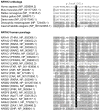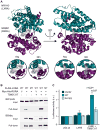Nuclear Receptor NR1H3 in Familial Multiple Sclerosis
- PMID: 27253448
- PMCID: PMC5092154
- DOI: 10.1016/j.neuron.2016.04.039
Nuclear Receptor NR1H3 in Familial Multiple Sclerosis
Erratum in
-
Nuclear Receptor NR1H3 in Familial Multiple Sclerosis.Neuron. 2016 Oct 19;92(2):555. doi: 10.1016/j.neuron.2016.09.028. Neuron. 2016. PMID: 27764675 No abstract available.
Abstract
Multiple sclerosis (MS) is an inflammatory disease characterized by myelin loss and neuronal dysfunction. Despite the aggregation observed in some families, pathogenic mutations have remained elusive. In this study, we describe the identification of NR1H3 p.Arg415Gln in seven MS patients from two multi-incident families presenting severe and progressive disease, with an average age at onset of 34 years. Additionally, association analysis of common variants in NR1H3 identified rs2279238 conferring a 1.35-fold increased risk of developing progressive MS. The p.Arg415Gln position is highly conserved in orthologs and paralogs, and disrupts NR1H3 heterodimerization and transcriptional activation of target genes. Protein expression analysis revealed that mutant NR1H3 (LXRA) alters gene expression profiles, suggesting a disruption in transcriptional regulation as one of the mechanisms underlying MS pathogenesis. Our study indicates that pharmacological activation of LXRA or its targets may lead to effective treatments for the highly debilitating and currently untreatable progressive phase of MS.
Copyright © 2016 Elsevier Inc. All rights reserved.
Figures



Comment in
-
The Added Value of Family Material in the Discovery of Multiple Sclerosis Genes.Neuron. 2016 Jun 1;90(5):905-6. doi: 10.1016/j.neuron.2016.05.027. Neuron. 2016. PMID: 27253441
-
Editorial Note to:Nuclear Receptor NR1H3 in Familial Multiple Sclerosis.Neuron. 2016 Oct 19;92(2):331-332. doi: 10.1016/j.neuron.2016.10.008. Neuron. 2016. PMID: 27764666 No abstract available.
References
-
- Cai F, Chen B, Zhou W, Zis O, Liu S, Holt RA, Honer WG, Song W. SP1 regulates a human SNAP-25 gene expression. J Neurochem. 2008;105:512–523. - PubMed
-
- Chalmin F, Rochemont V, Lippens C, Clottu A, Sailer AW, Merkler D, Hugues S, Pot C. Oxysterols regulate encephalitogenic CD4(+) T cell trafficking during central nervous system autoimmunity. J Autoimmun. 2015;56:45–55. - PubMed
Publication types
MeSH terms
Substances
Grants and funding
LinkOut - more resources
Full Text Sources
Other Literature Sources

